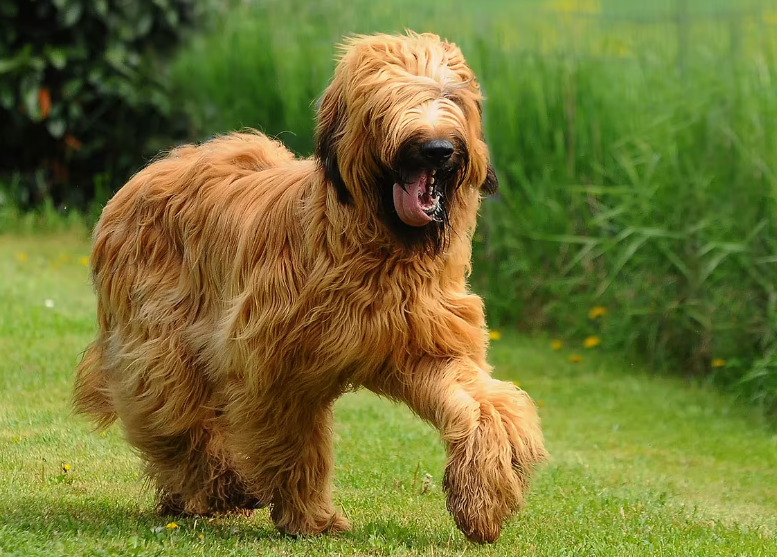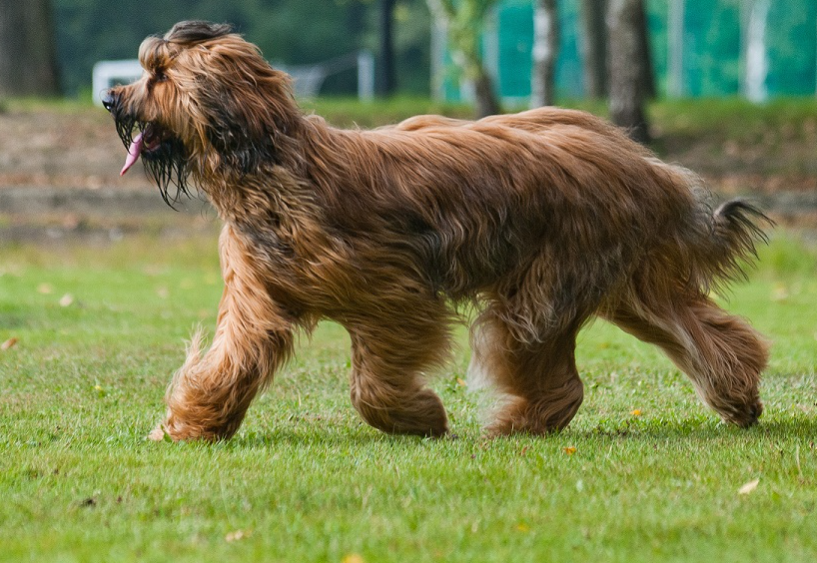
Intriguing facts about Briard dog breed
The Briard breed of large herding dogs originated in France. Briards are referred to as “hearts wrapped in fur” due to their loving and loyal nature, and they are distinguished by their distinctive long, shaggy hair. The males of these canines often weigh between 75 and 100 pounds and have a strong, muscular build, with a shoulder height of 23 to 27 inches. Females are somewhat smaller, measuring 22 to 25 inches tall, and weigh between 50 and 65 pounds.
Physical Appearance and colour of Briard dog
One of the most distinguishing features of the Briard is its luxurious double coat, which consists of a coarse outer layer covered in a silky, thick undercoat. To prevent matting and preserve this coat’s best look, frequent care is required. Briards may have markings on their paws and chest that are white, fawn, black, or grey. Other colours are also available for them.
Temperament and Personality of Briard dog
Briards are intelligent, confident, and protective by nature. They are well-known for their remarkable herding abilities and make excellent working dogs. However, they also make wonderful family friends and are known to be kind and tolerant with children. Among other canine sports, briards excel at tracking, obedience, and agility. They are also very trainable. Since they thrive on both physical and cerebral stimulation, they need regular exercise to be happy and healthy. When everything is said and done, the Briard is a loyal and adaptive breed that provides its owners with companionship and enjoyment.
Fascinating facts about the distinctive Briard breed
The Briard is a beautiful and perceptive dog breed with centuries of history. Briards are devoted dogs with long, shaggy hair, making them excellent working and companion dogs. Here are some fascinating details about the distinctive Briard breed that may pique your interest in bringing one home:
Overview of the Briard’s origin and history
The origins of the Briard, often called the Berger de Brie, may be traced back to France in the eighth century. Originally, they were developed to assist shepherds with their flocks by acting as herding dogs. Later, Briards’ intelligence and trainability led to their use as police and military dogs.

Size, length and physical appearance of Briard dog breed
Male briards measure approximately 23 to 27 inches (58 to 69 cm) at the shoulder, whereas female briards are somewhat smaller. Briards are huge dogs. They are built like muscles and have a unique, long, wavy, thick double coat. There are three colour options for the coat: tawny, grey, and black.
The Briard’s friendly nature and social instinct
Briards are renowned for their protective and devoted dispositions. They are excellent watchdogs because they are very committed to their families. Because they are also bright and eager to please, they are very trainable. They need constant training and early socialisation since they may be independent and difficult at times.
Early socialization makes Briard species kind and jovial
Although Briards are normally kind and sociable, they may need to be properly introduced to and socialised with new people and animals since they are suspicious of strangers. They get along well with kids and have a lot of patience and tolerance, but it’s always advisable to have supervision.
Briard’s dog needs regular exercise and mental stimulation
Because they are herding dogs, briards have a lot of energy and need to be exercised often to be happy and healthy. They like engaging in physical and mental challenges, such as hiking, long walks, and agility training. Obedience training and puzzle toys are two examples of mental stimulation that may help stop boredom and bad behaviour.
Briard’s dog’s aptitude for herding, obedience, agility, and tracking
Briards are excellent at tracking, obedience, and herding competitions, among other dog sports. They are intelligent and adaptable, making them good at a variety of jobs; they work best when given a task.
Briard’s dog-specific grooming needs
Regular grooming is necessary to maintain the best-looking coat on a briard. To help shield them from the weather, they develop a soft, thick undercoat below their harsh outer coat. It’s important to brush them once a week to avoid matting and maintain a healthy, tangle-free coat.
The importance of regular ear cleaning and bathing for Briard dog
Bathing them on a regular basis will also help to keep their coat tidy and clear of dirt and debris. Their lengthy hair may retain moisture, so it’s important to periodically examine and clean their ears to avoid infections.
Common health issues Briard dog breed can face
Although they are typically a healthy breed, bristles might have specific health issues, just like any other dog breed. Progressive retinal atrophy (PRA), bloating, and hip dysplasia are some of the major health problems seen in Briards. They may maintain excellent health with regular exercise, a balanced diet, and veterinarian check-ups.

Maintaining the overall health and well-being of Briard dog
The Briard is an intriguing breed with an impressive pedigree and many positive traits. They are excellent working dogs and friends because of their devotion, intelligence, and adaptability. But being a Briard owner means being committed to meeting your dog’s demands for exercise, grooming, and training. A Briard may fill your life with so much love and happiness, but only if you’re prepared to put in the work.
Briard dog breed’s potential as pet or working dog
Recall that getting a dog is a lifetime commitment, so before choosing a breed, do your homework and learn about it. To locate the ideal Briard for your family and learn more about this amazing breed, think about getting in touch with respectable rescue groups or breeders of Briards.